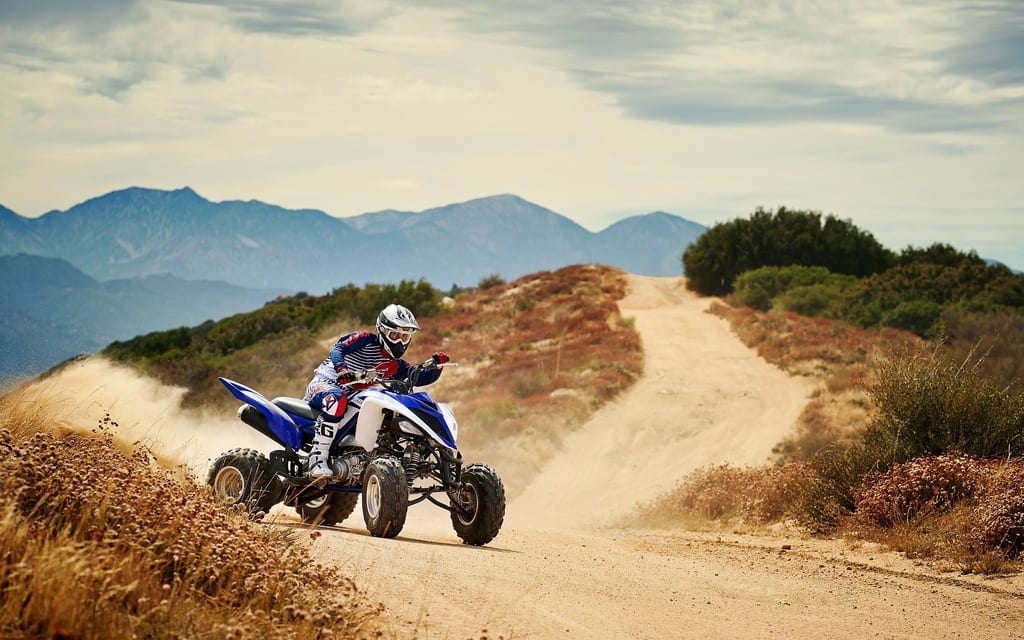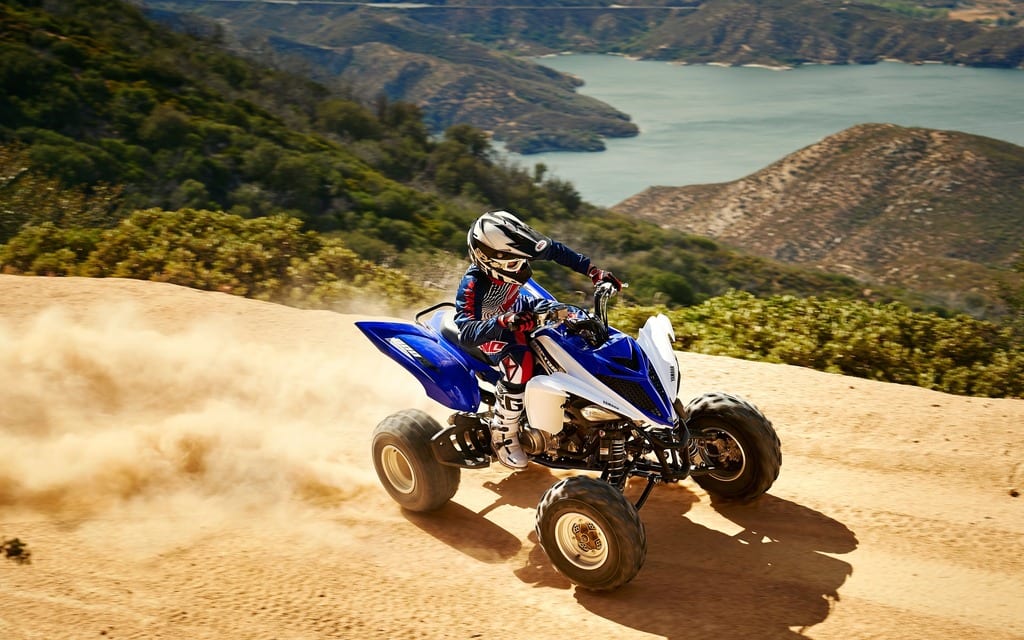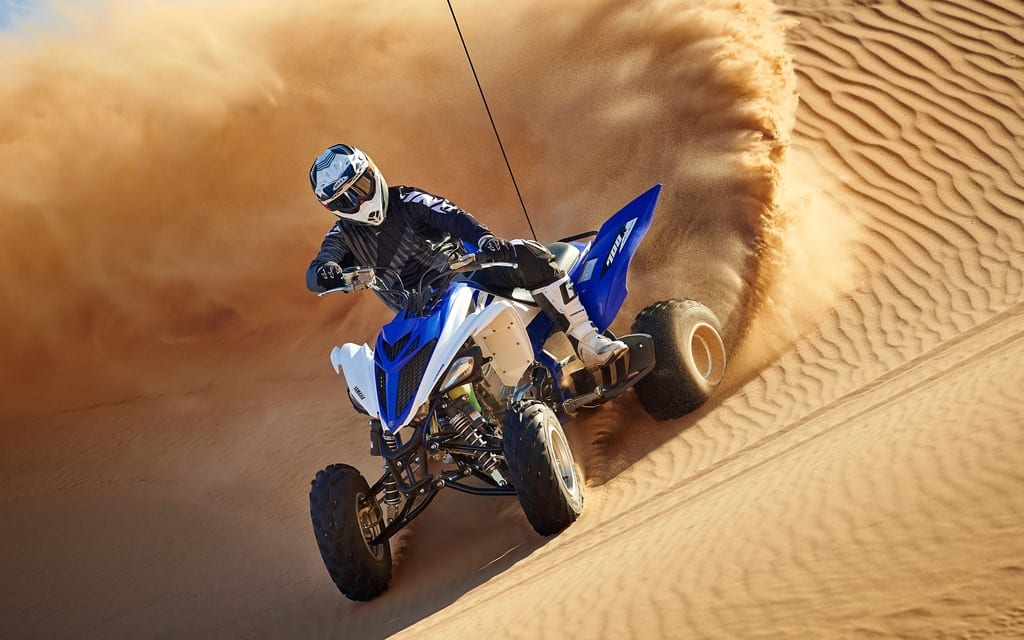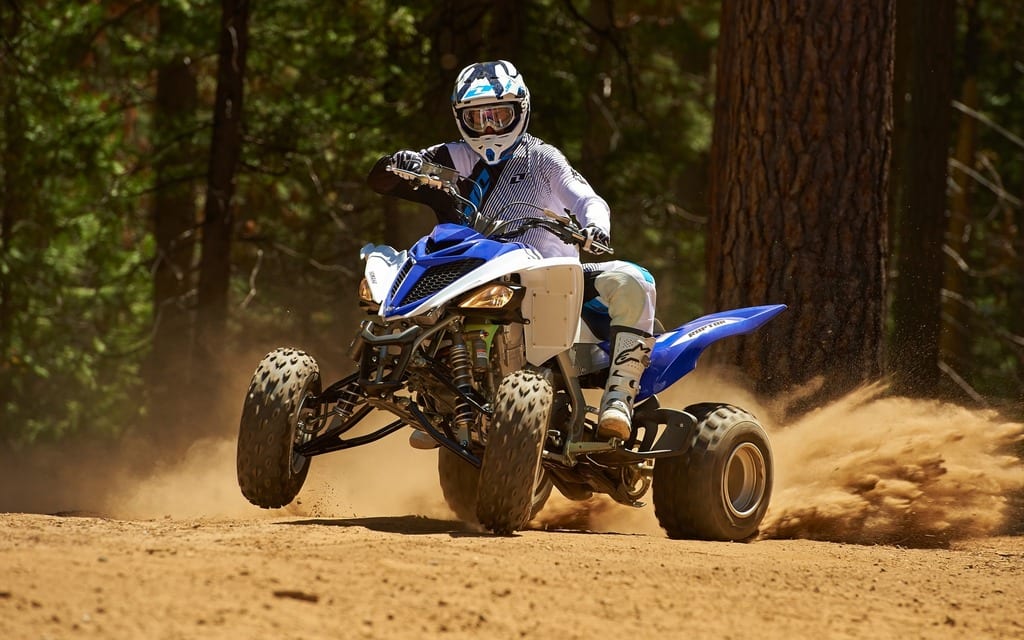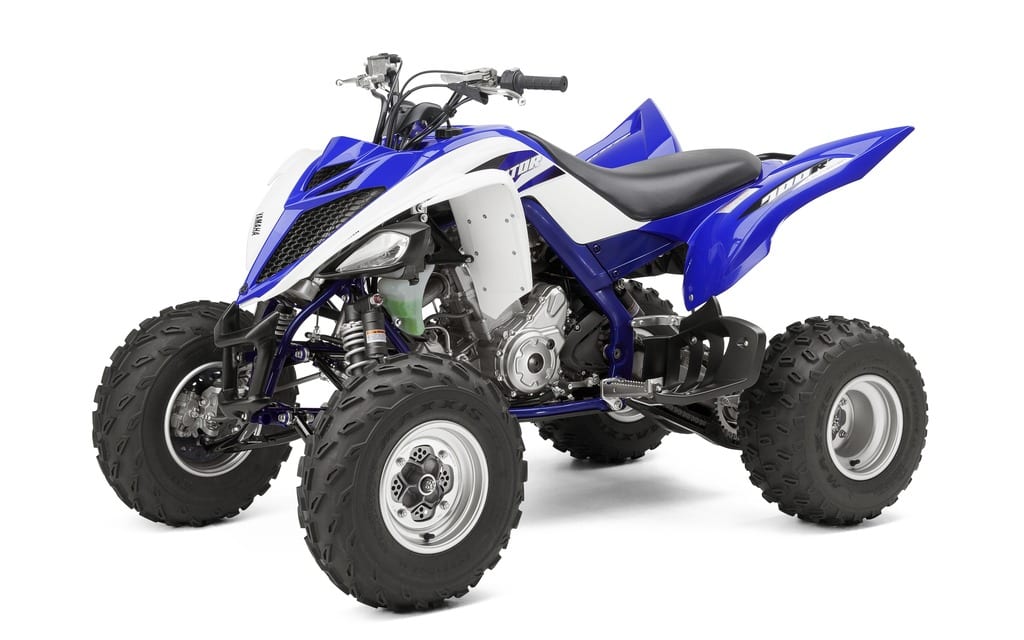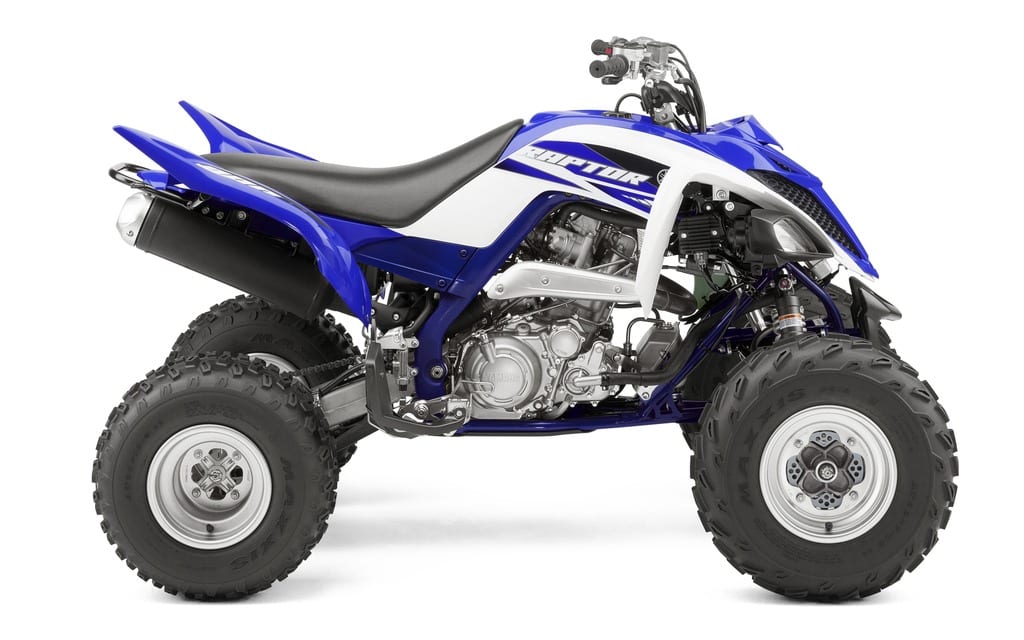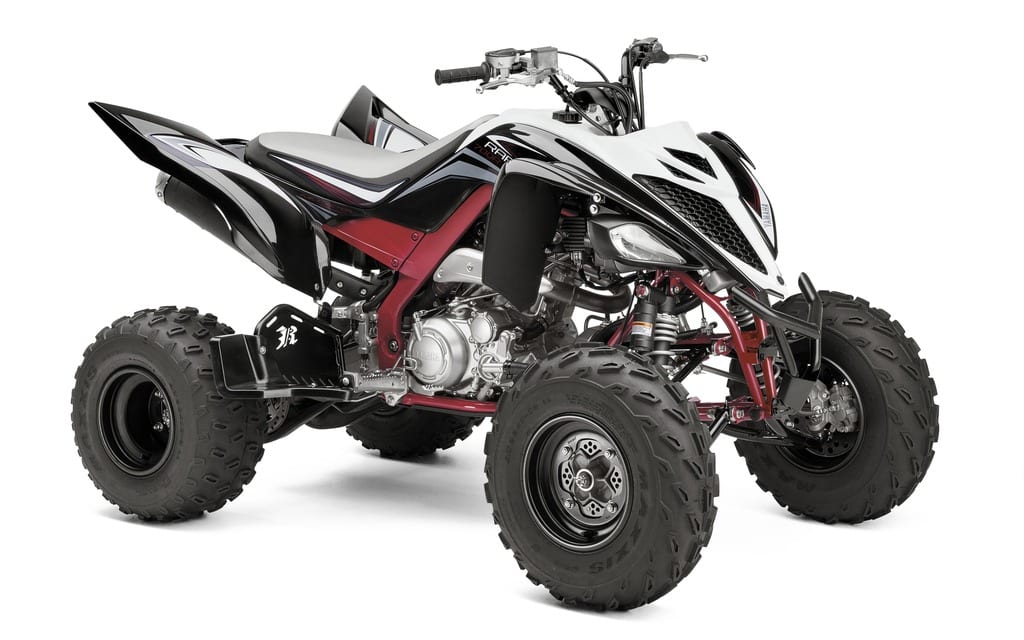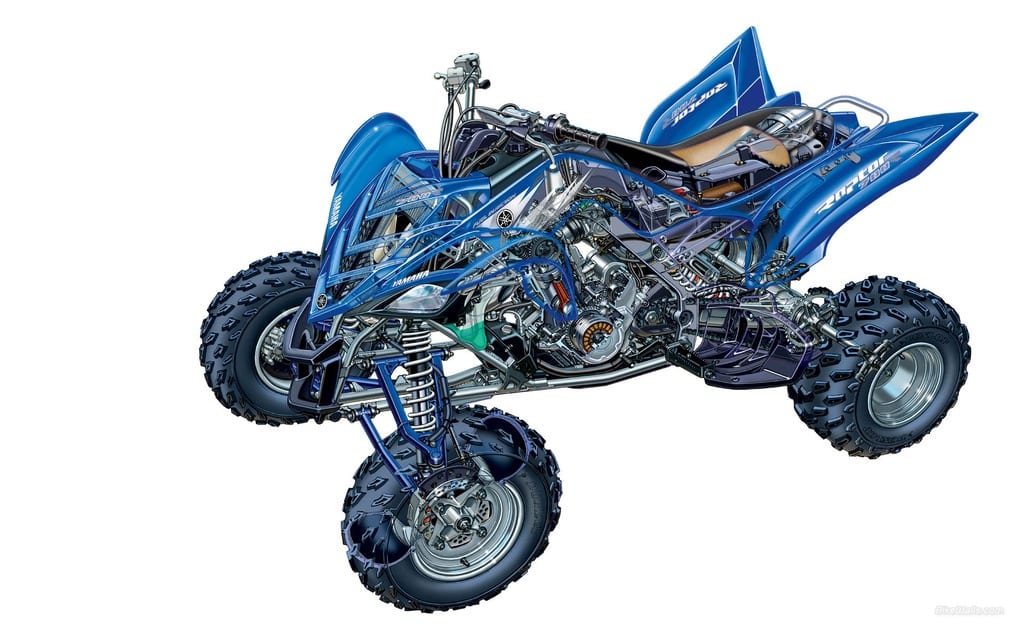With the introduction of the 660R Raptor, some 14 years ago, Yamaha created a new benchmark for sport ATVs. It offered the largest engine to ever be placed on a sport ATV at the time and still remains now and we foresee it for a long time, the most powerful and fun to ride sport quad ever built. So why give this particular 2015 version some love and space in our pages? Because they’ve yet again managed to make it even better and faster!
As far as we are concerned here at ATV Trail Rider, we will stay fans of sport quads well beyond our years. It was love at first sight and that love only grew stronger with time. Fitto, Fox and myself, all love getting a chance to ride any Raptor at any time. First ATV in history to use a 5-valve cylinder head, the Raptor 660R certainly had an outstanding engine backed with its YZ-spec, 5-speed manual transmission with maybe less greatness than expected for some who risked going first year with it in 2001. Some users complained about the ride sometimes popping out of gear under hard acceleration. 2002 gearing, offered a slightly different ratio as well as stronger components. Since then the model has gotten great reviews from everyone. Yamaha engineers are known to have been mentors and experts in the sport ATV world and stayed the most willing to put time and effort on keeping their sport-oriented offerings at the top of the game, so the Raptor has continued to evolve into a truly solid ride.
Yamaha has been for a long time and still is sponsor to several professional ATV riders in different areas of racing, such as cross-country racing and motocross. In recent years Yamaha has had great success in ATV motocross, with Dustin Nelson and Pat Brown, both racing the YFZ450. Pat Brown’s best season was a 3rd place title in 2007, while Nelson brought them two 1st place titles in the Yamaha/ITP Quadcross, one in 2006 and the other in 2008. Yamaha has had success in cross-country with their YFZ450, ridden by Bill Ballance, winning 9 straight titles since 2000. Traci Cecco, rode the YFZ450 to 7 titles, the first in 2000. So why not use a Raptor 700R in these races? Or, buy the YFZ450R for fun trail rides or to play in dunes? Well one could and some certainly did and still do take both of these avenues but that just isn’t using each machine’s true calling. We do spot Raptor 700Rs at drag races, in ice racing and even saw a few teams running them at the 12 hours of LaTuque race but those rides were graced with an impressive number of upgrades. We also cross paths with numerous YFZs on trails, there is very little difference in price, very little difference when you line both rides up against each other in a drag race, so how should one make up his or her mind on what’s best suited for them? Not an easy choice for sure; all we can do is try and talk about both these rides in this article focusing on the Raptor, in order to help you as much as we can through this tough task of choosing between two of the most satisfying rides, if not the very best sport quads on the market today.
While riding a 2015 Yamaha Raptor 700R in stock form, we discover a very intelligent balance between the slightly higher standing rider ergonomics and much narrower stance at 45.5 inches, which seems intended to scare you away from going super fast in a medium grade curve or off-camber turn, with healthy trees all around. At the same time, with its higher ergonomics, narrower footprint and cuts like a knife torque and throttle response, it lets you to carve through tighter flat turns with as much precision and maybe more ease than any 450. The YFZ is a generous 4.5 inches wider, has a lower and narrower seat and feels much better when taking flights in fast sequence. If you ride the YFZ and then switch to a Raptor, it is going to feel weird and maybe a bit scary on occasion. Rider size is something to consider but we see many big racers that feel very comfortable and wider and lower 450’s and we don’t think they would ever switch. Some of you might just like the more stable feel of the YFZ, even if you mostly ride in tight trails.
The difference in feel between the YFZ450R and 2015 Yamaha Raptor 700R is huge, yet both are equally satisfying in power, smoothness of the controls and of course simply a whole lot of fun to ride. The 700R is a great trail machine, good for hill climbing and a half-decent jumper. The YFZ450R shines much brighter on a full-on motocross style track, simply because that is what it was very specifically designed for, spending almost as much time in the air as on the ground. If you are not racing, then the 700R is an excellent choice, especially if you are a frequent all-day rider. If you think you might end up racing mx, then please go with the YFZ450R. It is much more expensive and difficult to turn a Raptor into a true motocross race-winning ride. The geometry differences can make racing it challenging. Plus why would you start with a heavier quad? Even if it is just 15 pounds heavier, at the races every once counts. Also, the Raptor has an entirely different power band than the 450. In stock trim, the 700R feels like it has more low-end grunt than the 450, making it great for rougher and sometimes tighter trails. Another fact to consider is that transitions from sitting down to standing up on the pegs are almost totally effortless on the Raptor, which combines well with the thicker seat. This fact only should make it the preferred choice for all-day trail riders.
Suspension wise you get just as much quality and adjustment possibilities on the Raptor than with the racy YFZ. Our friends in the U.S. can get this model in a more affordable Raptor 700 version; did you catch it? It’s just missing the “R” after 700. It comes with more basic shocks with only spring preload adjustability, but here in Canada we only have the Raptor 700R or 700R SE available to us, wearing a much better YZ-style KYB brand piggyback rear shock with high- and low-speed compression adjustability for maximum sport versatility, along with preload and rebound adjustments the precisely control all of its 10.1-inch in wheel travel and up front 9.1 inches of travel are handled by an independent double wishbone system using KYB piggyback shocks, with the same precise adjustment possibilities. The shocks have also been reworked to optimize handling characteristics. These new settings enhance rider comfort and reduce chances of bottoming.
Stopping this powerful beast, which boasts the best power-to-weight ratio in the industry, isn’t a problem as twin-piston calipers squeeze its perforated discs with unmatched smoothness and feel at the controls, as is the case with the YFZ. There are actually a lot of other similarities with the Raptor’s race-ready brother such as lightweight aluminum wheels to help enhance suspension performance by reducing unsprung weight and both rides use a combination of aluminum and steel for light weight and strength in their frames.
Proudly assembled in the U.S.A. in Newnan, Georgia, located about 30 minutes south of Atlanta, at their facility which employs over 1000 people and consists of three plants, alongside Yamaha’s 4×4 and Side x Side utility vehicles, The Raptor 700R is one very impressive machine. It can brutally take on just about any terrain, track or trail, dunes, muddy backcountry roads, and can even make it through decent mud puddles when the operator dares to push it to its full potential. Its potent engine which delivers explosive torque right off idle, will satisfy even the most experienced terrain conqueror and can still serve responsible beginners well. That being said, a lot of gals might prefer its feel, ergonomics and comfort, over a 50 inch wide 450. Clo, our lady test rider and photographer, enjoyed how smooth and easy that power is to control when just riding at a not too fast leisurely pace. The powerband is so well laid out that there is no need to be changing gears all that much when trekking through the woods. For an old trail wolf like me, third gear is a charm for many wood trails here in Quebec. I might use 4th gear for just a second or two when in the bubble but that’s it. No 5th gear needed for me, and boy do I love the fact that there is a reverse gear on this thing! It’s just a great to find on a sport quad. Clo stays in first and second and has a ball.
The 2015 Yamaha Raptor 700R is the way to go for those in search of big-bore quad feel, which some could find bordering craziness but leaves a guy like me with a lot more weight to carry than I wish I had to, with nothing more to hope for. Ok well except maybe for a little bit wider stance so I could put all that power down with even more confidence. At 6 feet and 3 inches tall and 200 whatever pounds (What? So I’ve recently put on a few and don’t want to even think about it right now.), this beast just feels like the perfect choice for me.
In 2006 a 686cc Yamaha engine turned the already satisfying Raptor into the 700R model, with a noticeable power gain, mostly felt at the bottom of the rpm range and at middle. This helped make it the most powerful ATV ever mass-produced, with big torque right off idle transitioning into a fat midrange and monstrous top end, which turns out to be a big plus when the rider needs to redirect this beast with precision. The Raptor was also the first fuel-injected ATV, which helped provide crisper, more consistent engine performance in a wide range of conditions, regardless of elevation or temperature, presenting a net advantage that many racers now want to profit from. The model also brought forward a first-of-its-kind steel and aluminum hybrid frame with aluminum sub frame and cast swingarm which ensured the Raptor 700R stayed class-leading and the lightest ATV in its class, even if it is going up against very few other big-bore sport models.
For 2015, the Raptor’s proven reliable 686cc engine with dual counter balancers to keep it smooth, got a few modifications to pump even more power out of it. An increase in compression from 9.2:1 to 10.0:1, changes made to the cylinder head and piston, valve timing and fuel injection mapping, all contribute in providing a noticeable 10% increase in power. It revs all the way to 9000 rpm quicker than ever.
Taking that extra power into account, they switched to new high-performance front 22×10-9 Maxxis tires with specially designed tread pattern to improve feel and control and kept the existing 20×10-9 rear tires which remain highly efficient at providing enough traction to get the front light at any given time and in a variety of terrain and conditions. The most impressive upgrade for this year is the 8% reduction in fuel consumption, despite the power gain. Always a welcome fact to be able to keep riding a little while longer on such a fun sport quad.
A new durable and long-lasting X-ring drive chain is used to drive power to the rear wheels is also new, as is the fact that the Raptor 700R is Yamaha Diagnostic Tool-ready for improved serviceability. It stays pretty much the same in looks but it’s nice to see them make an effort to distinguish this exciting model year for Raptor fans with little changes. What was blue is now white and vice-versa but the nice added touch is the painted blue frame.
Avant-garde looks, blended superbly with high-performance features and never before experienced power and torque, helped the Raptor win over quite the following. Every model year passing presented small differences to further improve it but it’s obvious that Yamaha engineers don’t want to change it up too much since it is so successful and pleases everyone lucky enough to get a chance to ride one. It is a very common sight to see anywhere ATVs are used for recreation. In fact a few specific units always seem to pop back into my brain every time I go for a test ride with other machines. These days it seems too many of the units I have to test have a steering wheel. I recently got a chance to experience lots of cool places to ride such as Brimstone recreational park, Glamis sand dunes, trails on the edge of Bryce Canyon in Utah, and I many times wished I was riding a Raptor instead. Still, I can’t complain, some Raptors I was lucky enough to ride in very cool places, others have just astonished me with their looks and performance at the races, such as racer Guy DeMontigny’s endurance-prepped Raptor, with impressive big Baja style lights and numerous DIY protection upgrades and aftermarket parts. He was the one that instigated the creation of the Ironman class in LaTuque, being the first rider to complete the gruelling 12-hour race alone instead of with two partners like most other teams. I won’t soon forget my awesome riding experience in and around an abandoned golf course with one either. Actually, the Raptor 700R seems to make any type of riding area amazingly fun.
It’s the kind of ride you can’t help but stand in front of and just stare at for a while after every ride. Then a huge grin sticks with you for a good while.
For more information on the above mentioned models, please visit the Yamaha Motor Website
More from Yamaha on ATV Trail Rider :
Yamaha ATV Models – Yamaha UTV Models – Yamaha ATV Reviews – Yamaha UTV Reviews


